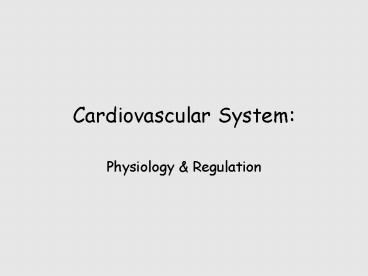Cardiovascular System: - PowerPoint PPT Presentation
1 / 25
Title:
Cardiovascular System:
Description:
Cardiovascular System: Physiology & Regulation. Blood flow. Aorta. Arteries. Arterioles ... Constitutively active = Vasomotor tone. Vasodilators ... – PowerPoint PPT presentation
Number of Views:16
Avg rating:3.0/5.0
Title: Cardiovascular System:
1
Cardiovascular System
- Physiology Regulation
2
Blood flow
- Aorta
- Arteries
- Arterioles
- Capillaries
- Venules
- Veins
- Vena cava
3
Overview
- Branching from Aorta to capillaries Convergence
from capillaries to Vena Cava - Blood Pressure Velocity ? to Area (cross
sectional) - Velocity slows as area increases.
- Pressure drops as area increases.
4
Effects of area distance
- F ? ?P/R
- Increased Pressure increased Flow
- Increased Resistance decreased Flow
- Cardiovascular Pressure
- Blood Pressure (BP) arterial
- ?P 65mm Hg
- Capillary hydrostatic pressure (CHP)
- ?P 17mm Hg
- Venous pressure ?P 18mm Hg
5
Effects of diameter distance
- F ? ?P/R
- Increased Resistance decreased Flow
- Vascular Resistance
- Vessel Length Diameter
- Longer vessel more friction Smaller diameter
more friction more SA of vessel walls in contact
with blood - Viscosity R caused by interaction of suspended
molecules solutes (stuff sticking together) - Turbulence irregular surfaces, high flow rates,
changes in diameter.
6
BP changes with distance
- From arterioles to capillaries
- BP drops quickly
- ?P drops quickly
- Systolic Diastolic
- 120/80
- Pulse difference
- MAP mean
- Hypertension (140/90) leads to gradual
enlargement of ventricle to compensate
7
Mechanisms of Capillary Exchange
- Diffusion Concentration gradient
- Occurs rapidly with short distances steep
gradients small particles - Avenues of exchange between endothelial cells
through fenestra protein channels cell
membranes major sinuses - Filtration Hydrostatic pressure
- Water and small solutes forced across capillary
wall, leaving large solutes proteins in blood
8
Capillary Exchange
- About 10 billion capillaries in the body
- Blood pressure (CHP)
- Forces fluid (but few dissolved solutes) into
interstitial space - Osmotic pressure
- Fluid (lacking dissolved blood proteins) moves
back into capillaries along solute concentration
gradient
9
CHP pushes H2O solutes OUT
- Large solutes stay in
- Small solutes pass between cells through pores
10
Hydrostatic vs. Blood Pressure
11
Capillary exchange
12
Taking BP
13
Acronyms
- Heart rate (HR)
- Blood Pressure (BP)
- Stroke Volume (SV)
- Medulla oblongata brainstem (MO)
- Vasomotor Center (VaC)
- Cardiovascular Center (CaC)
- Vasomotor Tone (VaT)
14
Cardiovascular regulation
- Autoregulation
- Local vasodilators and vasoconstrictors
- Neural mechanisms
- Cardiovascular centers
- Baroreceptors chemoreceptors measure arterial
pressure dissolved gases - Endocrine mechanisms
- Hormones produce both short long-term changes
15
Overview
16
Autoregulation Local control
- Sphincters contract or dilate based on
concentrations of - Nutrients (AA, glucose, fatty acids)
- Dissolved gases (O2, CO2 load, NO)
- Wastes pH altering ions (lactic acid, H, K)
- Inflammatory molecules (histamine, NO)
- Additional capillaries infiltrate areas to
satisfy increased energy demands
17
Neural Vasomotor
- Controlled by neurons in Cardiovascular center
(brainstem) - Vasoconstrictors
- Release NE most peripheral blood vessels
- Constitutively active Vasomotor tone
- Vasodilators
- Release ACh vessels servicing skeletal muscle
brain - Allows shunting of blood to/from major regions of
body
18
Neural Baroreceptor Reflex
- Carotid sinus aortic arch baroreceptors
- Increase stretch increased AP frequency to CaC
in MO - Stimulates parasympathetic neurons
- Inhibits sympathetic neurons
- Collectively decreases CO VaT
19
Summary
20
Chemoreceptor Reflex
- Carotid aortic bodies have receptors
- Communicate with MO
- O2 or pH drops, or CO2 increases
- Increase AP frequency
- CaC VaC decrease parasympathetic stimulation
increases sympathetic stimulation of heart - Increase CO, VaT
- Increase BP and blood flow to lungs MORE O2
21
Summary
22
Hormonal
- Adrenal Medullary
- Mechanisms that increase sympathetic stimulation
of heart vessels, also stimulate adrenal
medulla - Adrenal medulla releases epinephrine
- Epinephrine increases HR, SV causes
vasoconstriction of blood vessels in skin
viscera vasodilation of blood vessels in
skeletal cardiac muscle
23
Hormonal
- RAA pathway
- Stimulus BP drops
- kidney secretes Renin which turns on Angiotensin
- Angiotensin increase vasoconstriction BP rises
- Encourages adrenal medulla to produce aldosterone
- Aldosterone increases Na and H20 reclamation _at_
kidney BP rises - Stimulates secretion of ADH, stimulating H2O
reabsorption - Stimulates thirst mechanism
24
Hormonal
- Vasopressin (ADH) mechanism
- Stimulus plasma solute concentration increases
or BP decreases - ADH released from pituitary
- ADH stimulates vasoconstriction water
reclamation at kidney BP rises
25
- Pulmonary loop
- Gas exchange
- Systemic loop
- Nutrient delivery waste removal































